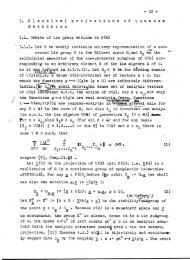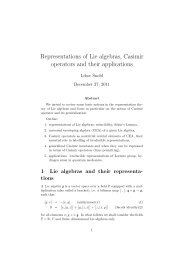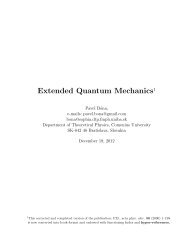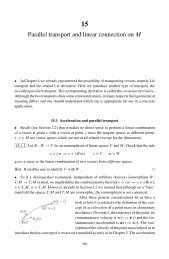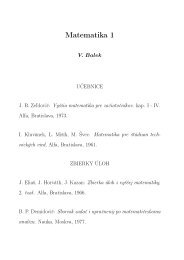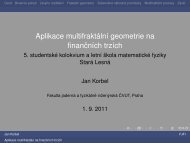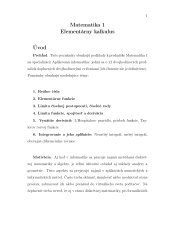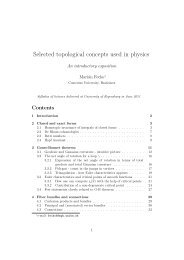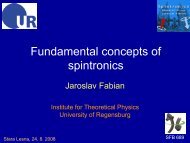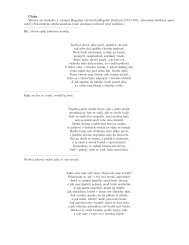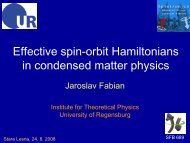Quantum Field Theory I
Quantum Field Theory I
Quantum Field Theory I
You also want an ePaper? Increase the reach of your titles
YUMPU automatically turns print PDFs into web optimized ePapers that Google loves.
42 CHAPTER 1. INTRODUCTIONS<br />
the scalar representation of the Poincaré group<br />
Investigations of the Poincaré group representations are of vital importance<br />
to any serious attempt to discuss relativistic quantum theory. It is, however,<br />
not our task right now. For quite some time we will need only the simplest<br />
representation, the so-called scalar one. All complications introduced by higher<br />
representations are postponed to the summer term.<br />
Let us consider a Hilbert space in which some representation of the Poincaré<br />
group is defined. Perhaps the most convenient basis of such a space is the<br />
one defined by the eigenvectors of the translation generators P µ , commuting<br />
with each other. The eigenvectors are usually denoted as |p,σ〉, where p =<br />
(p 0 ,p 1 ,p 2 ,p 3 ) stands for eigenvalues of P. In this notation one has<br />
P µ |p,σ〉 = p µ |p,σ〉<br />
and σ stands for any other quantum numbers. The representation of space-time<br />
translations are obtained by exponentiation of generators. If U (Λ,a) is the<br />
element of the representation, corresponding to the Poincaré transformation<br />
x → Λx+a, then U (1,a) = e −iaP . And since |p,σ〉 is an eigenstate of P µ , one<br />
obtains<br />
U(1,a)|p,σ〉 = e −ipa |p,σ〉<br />
And how does the representation of the Lorentz subgroup look like Since the<br />
p µ is a fourvector, one may be tempted to try U (Λ,0)|p,σ〉 = |Λp,σ〉. This<br />
really works, but only in the simplest, the so-called scalar representation, in<br />
which no σ is involved. It is straightforward to check that in such a case the<br />
relation<br />
U (Λ,a)|p〉 = e −i(Λp)a |Λp〉<br />
defines indeed a representation of the Poincaré group.<br />
Let us remark that once the spin is involved, it enters the parameter σ and<br />
the transformation is a bit more complicated. It goes like this: U (Λ,a)|p,σ〉 =<br />
∑<br />
σ ′ e −i(Λp)a C σσ ′ |Λp,σ ′ 〉 and the coefficients C σσ′ do define the particular representation<br />
of the Lorentz group. These complications, however, do not concern<br />
us now. For our present purposes the simplest scalar representation will be<br />
sufficient.<br />
Now it looks like if we had reached our goal — we have a Hilbert space<br />
with a representation of the Poincaré group acting on it. A short inspection<br />
reveals, however, that this is just the rather trivial case of the free particle. To<br />
see this, it is sufficient to realize that the operator P 2 = P µ P µ commutes with<br />
all the generators of the Poincaré group, i.e. it is a Casimir operator of this<br />
group. If we denote the eigenvalue of this operator by the symbol m 2 then the<br />
irreducible representations of the Poincaré group can be classified by the value<br />
of the m 2 . The relation between the energy and the 3-momentum of the state<br />
|p〉 is E 2 − ⃗p 2 = m 2 , i.e. for each value of m 2 we really do have the Hilbert<br />
space of states of a free relativistic particle. (The reader is encouraged to clarify<br />
him/herselfhow should the Hilbert space ofthe states of free relativistic particle<br />
look like. He/she should come to conclusion, that it has to be equal to what we<br />
have encountered just now.)<br />
Nevertheless, this rather trivial representation is a very important one — it<br />
becomes the starting point of what we call the particle-focused approach to the<br />
quantum field theory. We shall comment on this briefly in the next paragraph.



